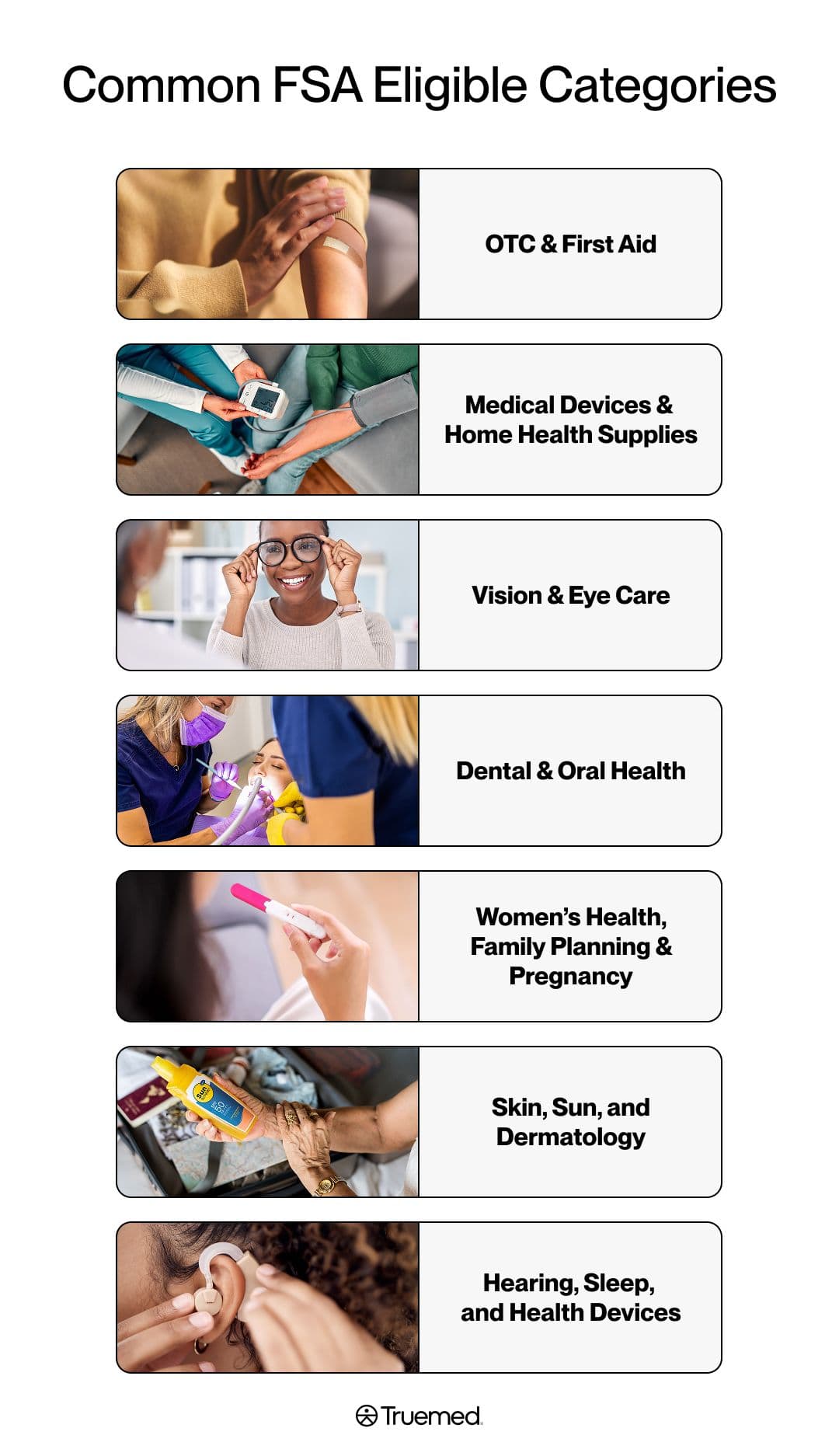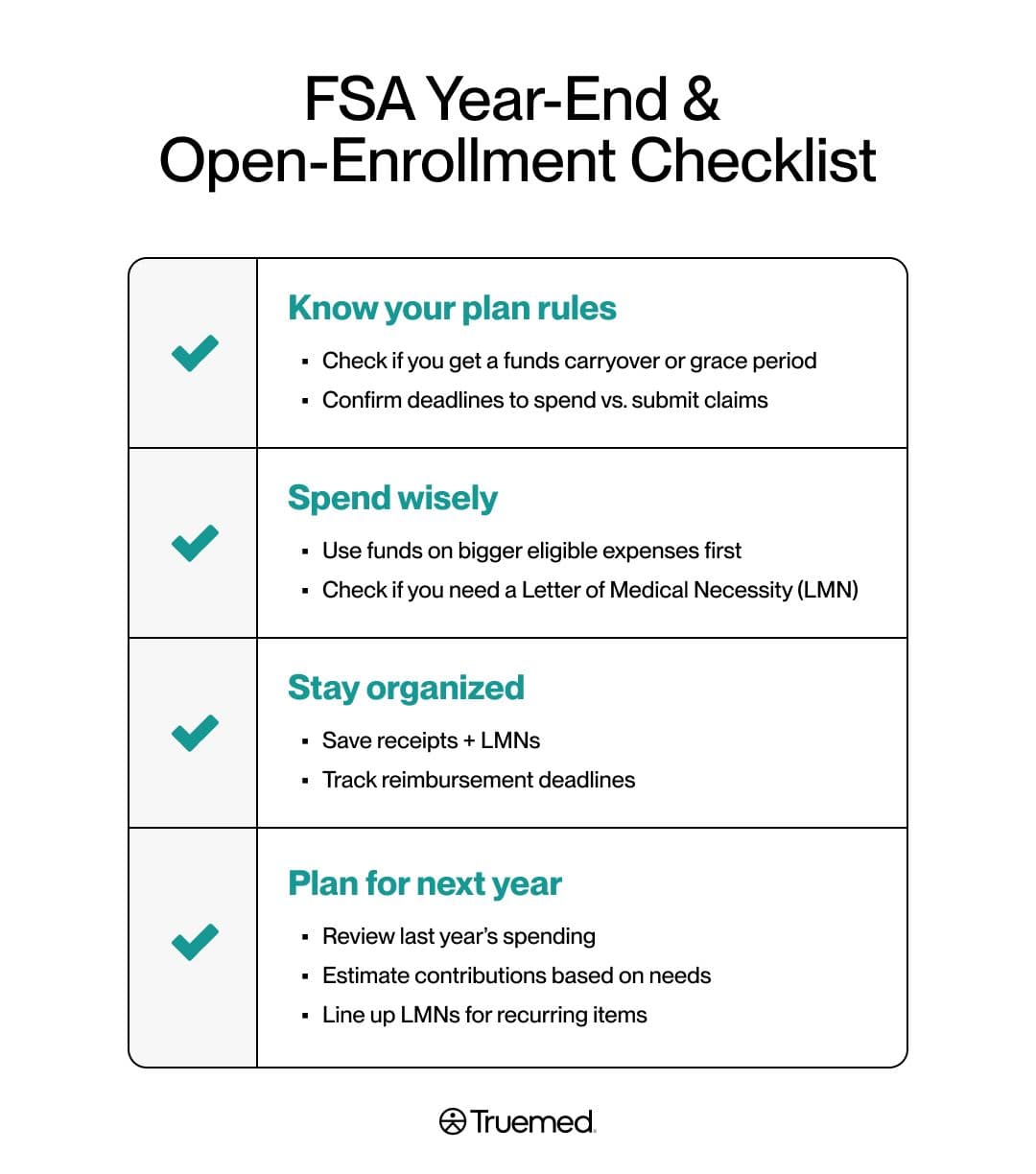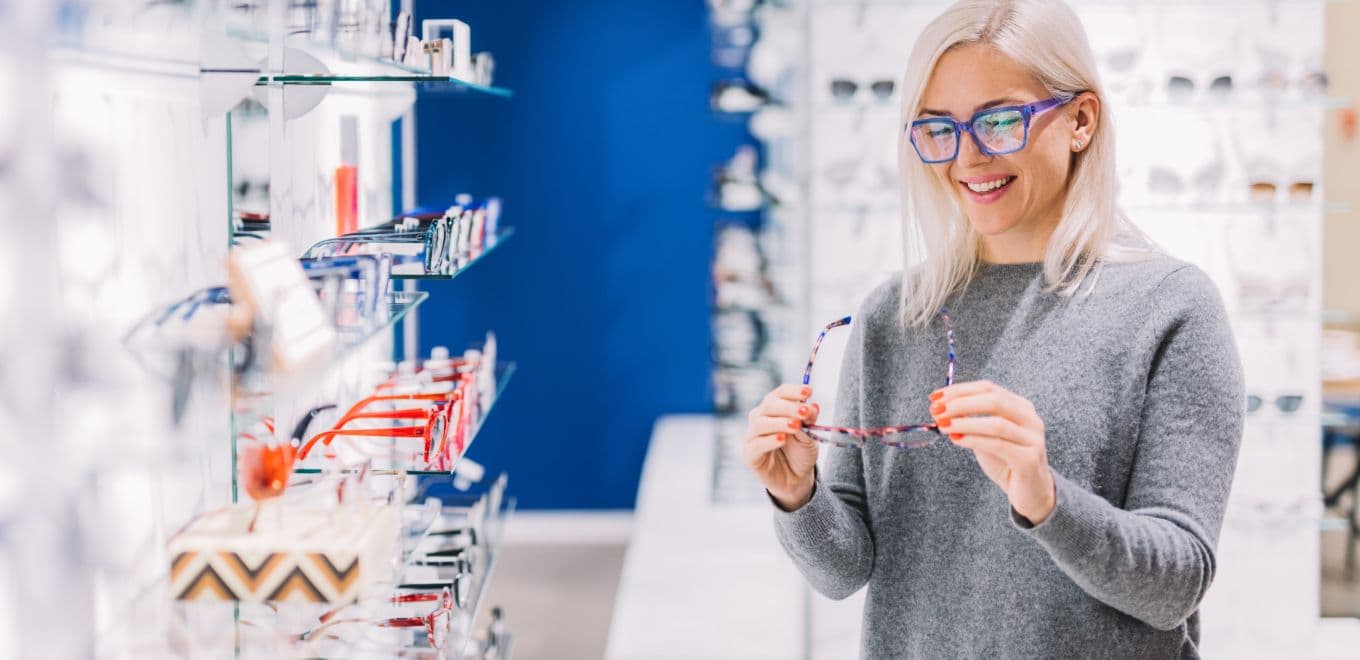70+ Top FSA Eligible Items
Author:Cheyenne Buckingham
Reviewed By:Michaela Robbins, DNP
Published:
November 17, 2025

FSA Eligible Items: What Counts and Why
Everyday FSA-Eligible Items (OTC & First Aid)
Medical Devices & Home Health Supplies
Vision & Eye Care
Dental & Oral Health
Women’s Health, Family Planning & Pregnancy
Skin, Sun, and Dermatology
Hearing, Sleep, and Health Devices
Items That Are Eligible But Typically Require a Prescription or LMN
What’s Usually Not Eligible (Common Pitfalls)
How to Use Your FSA with Truemed
Buying Guide: Make Every Dollar Count
Year-End & Open-Enrollment Strategy
Key Takeaways
FAQ
70+ Top FSA Eligible Items
If you’re wondering what you can use fsa for, you’re not alone—this information isn’t always obvious, and FSA plans vary based on your employer. Generally speaking, FSAs cover a wide variety of qualified medical expenses approved by the IRS. Not sure where to start? Check out this guide featuring the top FSA-eligible items.
A Flexible Spending Account (FSA) lets you use pre-tax dollars from your paycheck for eligible medical expenses like copays, prescriptions, and certain fitness equipment when used to manage a specific health condition. An FSA can help cover costs of products and services used for medical care.
Many items may be FSA-eligible for qualified customers through your employer-sponsored plan. Some items, such as certain health technology products and gym memberships, typically require a Letter of Medical Necessity (LMN) written by an independent licensed provider explaining the medical need.
In this guide, we’ll highlight examples of FSA-approved items, note which may require a prescription or LMN, and share simple strategies to use your funds confidently.
FSA Eligible Items: What Counts and Why
Identifying FSA-eligible items doesn’t have to be hard—the key is to understand the difference between two key phrases: “eligible” and “requires substantiation.”
All FSA expenses must be for the diagnosis, cure, treatment, mitigation, or prevention of a diagnosed medical condition. Certain items that are inherently medical and have no non-medical use are generally FSA-eligible when used for that purpose. For example, prescription medications and many medical devices (such as blood pressure monitors or continuous glucose monitors) are used to manage a diagnosed condition.
Other products and services—like gym memberships or some fitness gear—can have both medical and non-medical uses. These may be FSA-eligible with an LMN from an independent licensed practitioner explaining that the item is needed to treat or prevent a diagnosed medical condition. Eligibility is not guaranteed and depends on the customer and product.
When in doubt, keep your receipts.
“Always carry itemized receipts, not just credit card slips,” says Clayton Eidson, a health insurance agent and founder and CEO of AZ Health Insurance Agents. “The receipt must reflect the name of the merchant, product or service, and the date.”
If you used your FSA to pay for a certain service, such as physical therapy or a chiropractic appointment, you will likely need an Explanation of Benefits (EOB) or a statement from a licensed practitioner that says that service is required for your health.
“I suggest developing a digital folder where you can put all your FSA receipts and upload them right after buying [something]—it will save you time and frustration in the future,” Eidson says.
Keep in mind that FSA rules vary by plan. Typically, FSAs follow a “use-it-or-lose-it” rule—if you don’t spend the money you allocated into your plan year, you lose what’s left. But, some plans may include a carryover amount or a grace period for unused funds. Plan details differ, so check your plan before making a purchase.
“Reading the fine print [of your plan] really matters—not just for getting the most out of your FSA, but also for avoiding forfeiting funds,” says R.J. Weiss, CFP, and founder and CEO of The Ways To Wealth.

Everyday FSA-Eligible Items (OTC & First Aid)
A common misconception is that FSA-eligible purchases must be prescription-only or only cover doctor-related bills (like copays), Weiss says. In reality, many everyday items are FSA-eligible when used for medical care. These may include:
1. Pain relievers (like ibuprofen and acetaminophen)
2. Allergy medicines (like Claritin and Zyrtec)
3. Heartburn and digestive aids
4. Cold and flu drugs and other remedies
5. Menstrual care products (like pads, tampons, and cups)
6. First aid supplies (like bandages and antiseptics)
7. Bug bite relief products
8. Anti-Bacterial Hand Sanitizer
9. Thermometers
10. Wound dressings
11. Hot and cold packs
12. Burn care supplies
Medical Devices & Home Health Supplies
13. Blood pressure monitors
14. Glucose meters and strips
15. Orthopedic supports (like an ankle brace)
16. Pulse oximeters (which track your pulse via your fingertip)
17. Medical-grade compression socks (for blood circulation support)
18. Nebulizers
19. TENS units
20. CPAP machines and accessories
21. Mobility aids (like crutches, walkers, and wheelchairs)
22. CPR mask kits
Vision & Eye Care
23. Prescription eyeglasses and contact lenses
24. Eye solution drops
25. Reading glasses
26. Prescription sunglasses
27. Eye doctor copayment for eye exam
28. Lens cleaners
29. Eyewear repair kits
30. Cooling gel eye masks for migraine relief
31. Dry eye masks
Dental & Oral Health
32. Dental cleanings and exams
33. Procedures like fillings, crowns, and root canals
34. Orthodontics (like braces or Invisalign)
35. Wisdom teeth removal
36. Dentures
37. Dental medical kits (for folks who are hiking or otherwise traveling and don’t have immediate access to a dentist)
38. Cold sore treatments
39. Mints for dry mouth relief
40. OTC dental items when used for medical use (like fluoride treatments)
41. Night guards for teeth grinding and conditions like TMJ (needs documentation from licensed medical provider)
42. Retainer and night guard cleaning devices
Women’s Health, Family Planning & Pregnancy
43. Prenatal vitamins
44. Childbirth classes
45. Childbirth expenses and bills
46. Breast pumps and lactation supplies
47. Fertility treatments
48. Egg and sperm storage
49. Doula services (typically require an LMN)
50. Postpartum supports (be sure to read your plan’s rules about what’s eligible)
51. Ovulation kits
52. Pregnancy tests
Skin, Sun, and Dermatology
53. Sunscreen SPF 15+ and above
54. Mineral-based sunscreens
55. Lip balms with SPF 15+
56. Lip and skin ointments
57. OTC acne treatments like serums, creams body washes, and patches
58. Eczema and psoriasis treatments (either specified on label or prescribed)
59. Dermatologist visits and copays
60. Prescribed topicals
61. Makeup with SPF 15+
Hearing, Sleep, and Health Devices
62. Hearing aids and batteries
63. Hearing exams
64. Ear wax removal drops
65. Ear irrigation kits and devices
66. Sleep aids (like nasal strips or OTC drugs)
67. Sleep apnea supplies (CPAP devices, masks, filters)
68. Select health devices with an LMN, like fitness trackers and watches
69. Assistive technology (like toilet seat risers)
70. Acupressure mats
71. ENT and sleep specialists' copays

Items That Are Eligible But Typically Require a Prescription or LMN
Make sure you either have a prescription or an LMN ready before using your FSA to purchase these items.
72. Vitamins, minerals, and supplements (excluding prenatals)
73. Fitness programs and equipment (a licensed healthcare provider needs to specify which medical condition this will help you manage or treat)
74. Massage therapy or chiropractic maintenance care beyond acute treatment
75. Orthotics beyond standard inserts or specialty medical footwear (may require an LMN or a prescription)
76. Air purifiers and humidifiers (a provider needs to document the medical need)
77. In-home (or in yard) saunas and cold plunges (LMN is often required)
78. Botox injections for medical uses (relief for conditions like TMJ, chronic migraines, and hyperhidrosis)
What’s Usually Not Eligible (Common Pitfalls)
While there are so many FSA-eligible expenses, there are a few services and items that you shouldn’t use your FSA card for. These include:
- Cosmetic procedures and non-medicated cosmetics and skin care items. This includes Botox injections for wrinkle reduction, regular makeup, and skincare creams that don’t help clear up acne or manage skin conditions like eczema.
- Household items without a documented medical purpose. This can include anything that doesn’t qualify as a medical expense, such as essential oil diffusers, deodorant, decorative pillows, and yoga mats for general fitness or relaxation.
- Double-dipping an expense across multiple accounts. Plan rules generally prohibit submitting the same expense to more than one account (for example, both your FSA and your spouse’s FSA). Similarly, you can’t pay with an FSA card and then submit the same expense for reimbursement. Plan details vary, so check your plan before submitting a claim.
How to Use Your FSA with Truemed
Before you use your FSA card, check your plan details to see whether your planned purchase requires an LMN. If an LMN is needed, Truemed* can help by connecting eligible customers with independent practitioners to review a health survey and determine eligibility. Note that Truemed itself does not issue LMNs; clinicians make these decisions and may issue LMNs where appropriate.
All you have to do is pay with your FSA card or submit for reimbursement with an LMN and provide an itemized receipt with your claim. Always remember to keep digital copies of your receipts and LMNs for substantiation and future audits.
*Truemed is for qualified customers. See terms at truemed.com/disclosures.
Buying Guide: Make Every Dollar Count
“Finding the balance between underfunding and overfunding your FSA is difficult,” Weiss says. Remember: an FSA lets you set aside pre-tax dollars for qualified medical expenses, which may lower your taxable income. If you expect eligible expenses, consider that when choosing your contribution amount at the beginning of your plan year.
To help avoid claim-processing delays as your plan year ends, consider the following approaches:
- Choose clearly labeled medical products—it can make claim approval faster and easier
- Save itemized receipts and EOBs
- Record model and size specifics on health technology and devices before submitting a claim
- Consider setting a 90-day (quarterly) rhythm—restock your essentials, schedule any care appointments, and check your FSA balance
Year-End & Open-Enrollment Strategy
The key is knowing whether your FSA offers a carryover or a grace period. A carryover is just what it sounds like—unused funds from your current plan year can roll over into the next one, up to a set limit. According to the IRS, the maximum carryover amount in 2205 is $660.
If your plan doesn’t permit carryovers, it may offer a grace period. “Many plans have grace periods that allow you to use up your funds even past the end of the plan year,” Rebell says.
Another smart move is to use your funds on higher-cost items first—like prescription eyewear, dental procedures, or eligible health equipment and technology. If you’re submitting for reimbursement with an LMN, stay organized with your paperwork and deadlines. “The deadline to make an eligible purchase is often different from the deadline to submit for reimbursement,” Rebell explains.
Finally, consider keeping a record of all the medical expenses you had last year so you know what amount to contribute in your next plan year. You can review which items may require an LMN in advance and use Truemed to connect with independent licensed practitioners for the documentation where required, helping you submit complete claims.

The bottom line: There’s no shortage of FSA-eligible items. However, that doesn’t mean that every wellness product, fitness tool, or skincare essential is going to be covered. Do your research in advance by reviewing your plan’s specific eligibility rules. Save your receipts and seek out an LMN to maximize your covered health spending. Don’t forget to submit claims for reimbursements on time to avoid processing delays and make every dollar in your FSA count.
Your FSA can be used to cover copayments for doctor appointments.: It can also help you cover prescription drugs, over-the-counter medications and remedies.
Your FSA covers everyday health products beyond the doctor’s office.: Many products, such as first aid kit supplies, assistive devices such as hearing aids, and even menstrual care products are FSA-eligible items. The key here is to make sure that the item you want to purchase is an IRS-approved qualified medical expense.
An LMN may be necessary for certain items. : If you want to buy a sauna, certain supplements, or an air purifier with your FSA, you may need to provide an LMN from your doctor or an independent licensed practitioner through Truemed confirming the item is part of your treatment or prevention plan for a specific health condition.
Truemed makes it easy. : Truemed simplifies the LMN process and offers a curated marketplace of evidence-backed health interventions that may be eligible for FSA spending for qualified individuals. It takes the guesswork out of the process so you can focus on your health, not navigating the fine print.
Editorial Standards
At Truemed, we believe better health starts with trusted information. Our mission is to empower readers with accurate and accessible content grounded in peer-reviewed research, expert insight, and clinical guidance to make smarter health decisions. Every article is written or reviewed by qualified professionals and updated regularly to reflect the latest evidence. For more details on our rigorous editorial process, see here.


